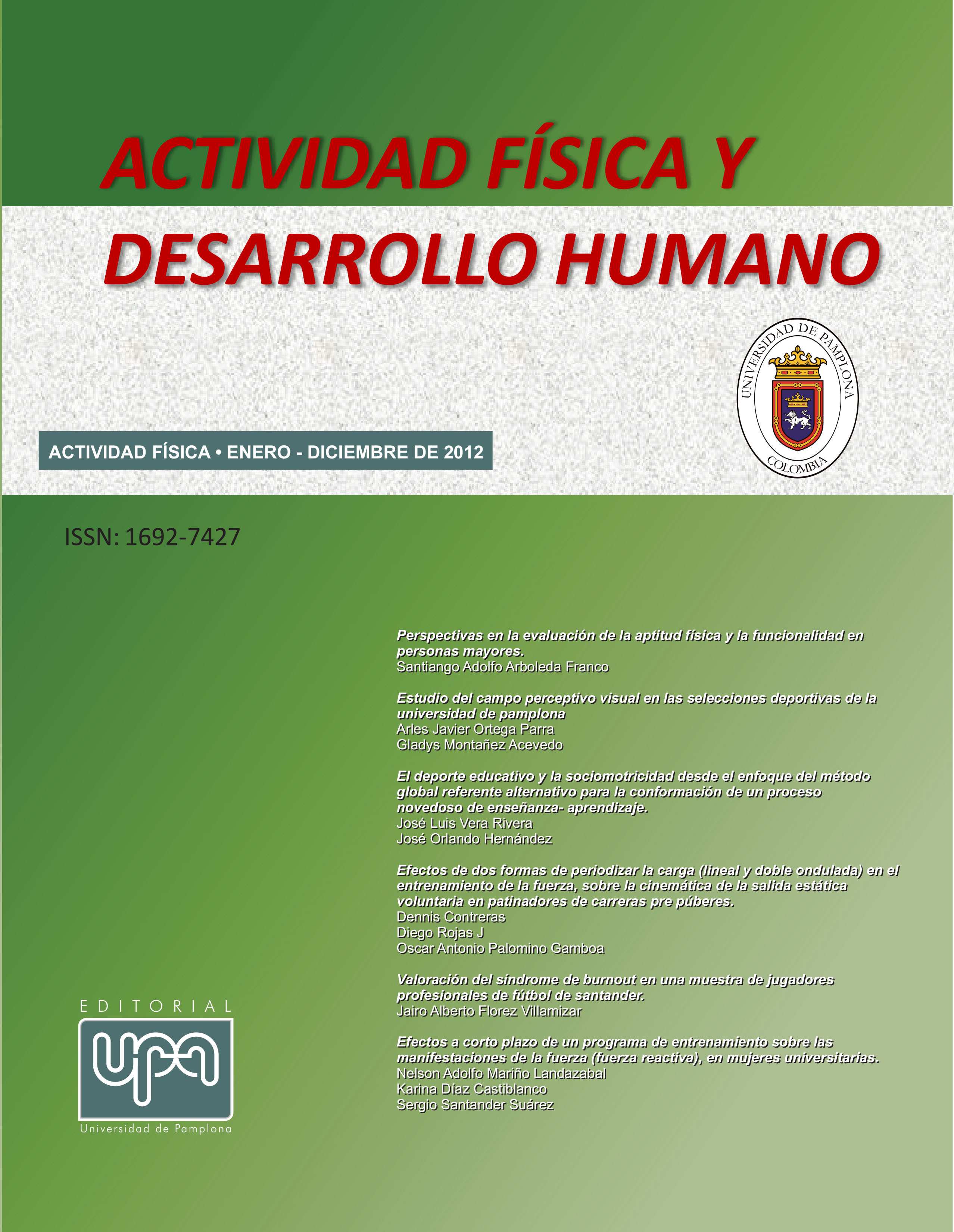Effects of two forms of periodization of load—linear and double undulating—in strength training in physically active women
DOI:
https://doi.org/10.24054/afdh.v4i1.1727Keywords:
Carga, periodización, fuerza, mujeresAbstract
The purpose of this study was to compare linear periodization (LP) and double-wave periodization (DWP) for gains in strength, power, and speed. Fourteen women aged between 30 and 45 years were randomly assigned to the linear periodization (LP) group (n=7) and undulating periodization (UP) group (n=7). A maximum repetition (1RM) and power for bench press and leg squat exercises and 20-meter sprint speed were recorded as initial (test 1), intermediate (test 2), and final (test 3) of the training program. The Shapiro-Wilk test and Bartlett's test were applied to verify normality and homogeneity of variances. The results obtained confirm that these assumptions were not violated. Descriptive values were calculated for the samples, and the Student's t-test for related samples was applied to each pair of samples. The statistical package used was SPSS version 15.0 and STATISTX 8.0, and in all cases a significance level of 5% was used. The analyses revealed that linear periodization of the load causes greater gains in percentage terms in the established speed variable, both in seconds and in meters/sec, and in the strength variable evaluated by means of the bench press test and the squat test. For the power variable evaluated in the same tests, it was found that in the bench press exercise, wave periodization was more effective in the short term. Linear periodization had greater increases in the long term. In terms of the squat exercise, the best results were achieved with linear periodization.
Downloads
References
Aagaard, P., Simonsen, E. B., Andersen, J. L., Magnusson, P., & Dyhre-Poulsen, P. (2002). Neural adaptation to resistance training: Changes in evoked V-wave and H-reflex responses. Journal of Applied Physiology, 92(6), 2309–2318. https://doi.org/10.1152/japplphysiol.01002.2001
American College of Sports Medicine. (2002). Position stand: Progression models in resistance training for healthy adults. Medicine and Science in Sports and Exercise, 34(2), 364–380.
Christopher, J. H., Feigenbaum, M. S., & Franklin, B. A. (2001). Prescription of resistance training for healthy populations. Sports Medicine, 31(14), 953–964.
Declaración de Helsinki de la Asociación Médica Mundial. (1964). Recomendaciones para guiar a los médicos en la investigación biomédica en personas. Asamblea Médica Mundial. Reformulada en Tokio (1975), Venecia (1983) y Hong Kong (1989).
Fleck, S. J., & Kraemer, W. J. (1988). Resistance training: Basic principles, part 1. The Physician and Sportsmedicine, 16(3), 160–171.
Hass, C. J., Feigenbaum, M. S., & Franklin, B. A. (2001). Prescription of resistance training for healthy populations. Sports Medicine, 31(14), 953–964.
Heredia Elvar, J. R., Donate, F. I., Chulvi Medrano, I., & Costa, M. R. (2006). Mitos y realidades en el entrenamiento de fuerza y salud. PubliCE Standard. https://www.sobreentrenamiento.com
Izquierdo, M. (2008). Biomecánica y bases neuromusculares de la actividad física y del deporte: Prescripción del entrenamiento de la fuerza (pp. 664–665). Madrid: Editorial Médica Panamericana.
Jiménez, A., & De Paz, F. (2004). La periodización en el entrenamiento de la fuerza. Revista Digital EFDeportes, (72). http://www.efdeportes.com/efd72/fuerza.htm
Kraemer, W. J., & Ratamess, N. A. (2004). Fundamentals of resistance training: Progression and exercise prescription. Medicine and Science in Sports and Exercise, 36(4), 674–688.
Lemmer, J. T., Ivey, F. M., Ryan, A. S., Martel, G. F., Hurlbut, D. E., Metter, J. E., Fozard, J. L., Fleg, J. L., & Hurley, B. F. (2001). Effect of strength training on resting metabolic rate and physical activity: Age and gender comparisons. Medicine and Science in Sports and Exercise, 33(4), 532–541.
Matsudo, S., Matsudo, V., & Barros, T. L. (2001). Atividade física e envelhecimento: Aspectos epidemiológicos. Revista Brasileira de Medicina do Esporte, 7(1), 2–14.
Ministerio de la Protección Social. (2008). Situación de salud en Colombia: Indicadores básicos.
Ministerio de Salud. (1993). Resolución número 8430 de 1993. Colombia.
Naclerio, A. F. (2005). Entrenamiento de fuerza y prescripción del ejercicio. En A. Jiménez (Ed.), Entrenamiento personal: Bases, fundamentos y aplicaciones (pp. 87–133). INDE.
Naclerio, A. F. (2007). Programación e integración del entrenamiento de fuerza en la preparación de los deportes de conjunto. PubliCE Premium. https://www.sobreentrenamiento.com
Pollock, M. L., & Vincent, K. R. (1996). Resistance training for health. President’s Council on Physical Fitness and Sports Research Digest, Series 2(8), 1–9.
Rhea, M. R., Ball, S. D., Phillips, W. T., & Burkett, L. N. (2002). A comparison of linear and daily undulating periodized programs with equated volume and intensity for strength. Journal of Strength and Conditioning Research, 16(2), 250–255.
Wernbom, M., Augustsson, J., & Thomeé, R. (2007). The influence of frequency, intensity, volume and mode of strength training on whole muscle cross-sectional area in humans. Sports Medicine, 37(3), 225–264.
Downloads
Published
Issue
Section
License
Copyright (c) 2012 ACTIVIDAD FÍSICA Y DESARROLLO HUMANO

This work is licensed under a Creative Commons Attribution-NonCommercial-NoDerivatives 4.0 International License.











